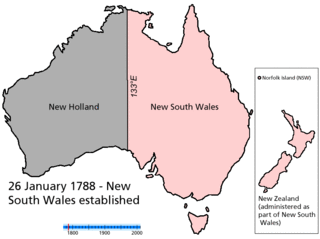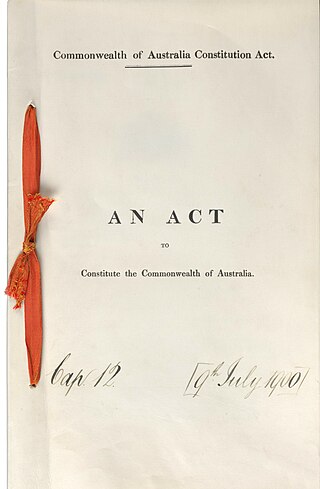Responsible government is a conception of a system of government that embodies the principle of parliamentary accountability, the foundation of the Westminster system of parliamentary democracy. Governments in Westminster democracies are responsible to parliament rather than to the monarch, or, in a colonial context, to the imperial government, and in a republican context, to the president, either in full or in part. If the parliament is bicameral, then the government is usually responsible first to the parliament's lower house, which is more representative than the upper house, as it usually has more members and they are always directly elected.

Suffrage, political franchise, or simply franchise is the right to vote in public, political elections and referendums. In some languages, and occasionally in English, the right to vote is called active suffrage, as distinct from passive suffrage, which is the right to stand for election. The combination of active and passive suffrage is sometimes called full suffrage.

The second question of the 1967 Australian referendum of 27 May 1967, called by the Holt government, related to Indigenous Australians. Voters were asked whether to give the Commonwealth Parliament the power to make special laws for Indigenous Australians in states, and whether Indigenous Australians should be included in official population counts for constitutional purposes. The term "the Aboriginal Race" was used in the question.
In Australia, referendums are public votes held on important issues where the electorate may approve or reject a certain proposal. In contemporary usage, polls conducted on non-constitutional issues are known as plebiscites, with the term referendum being reserved solely for votes on constitutional changes, which is legally required to make a change to the Constitution of Australia.
Human rights in Australia have largely been developed by the democratically elected Australian Parliament through laws in specific contexts and safeguarded by such institutions as the independent judiciary and the High Court, which implement common law, the Australian Constitution, and various other laws of Australia and its states and territories. Australia also has an independent statutory human rights body, the Australian Human Rights Commission, which investigates and conciliates complaints, and more generally promotes human rights through education, discussion and reporting.

Women's suffrage – the right of women to vote – has been achieved at various times in countries throughout the world. In many nations, women's suffrage was granted before universal suffrage, in which cases women and men from certain socioeconomic classes or races were still unable to vote. Some countries granted suffrage to both sexes at the same time. This timeline lists years when women's suffrage was enacted. Some countries are listed more than once, as the right was extended to more women according to age, land ownership, etc. In many cases, the first voting took place in a subsequent year.

Since the 19th century, there have been proposals for the creation or incorporation of new states of Australia. Chapter VI of the Constitution of Australia provides for the admission of new states to the federation. Proposals have included admitting territories to statehood, admitting independent countries, and forming new states from parts of existing states. However, no new states have been added since the federation of six former British self-governing colonies in 1901, as states of the new Commonwealth of Australia.

The Commonwealth Franchise Act 1902(Cth) was an Act of the Parliament of Australia which set out who was entitled to vote in Australian federal elections. The Act established, in time for the 1903 Australian federal election, suffrage for federal elections for those who were British subjects over 21 years of age who had lived in Australia for six months. The Act excluded natives of Australia, Asia, Africa and the Pacific Islands (other than New Zealand) from the federal franchise, unless they were already enrolled to vote in an Australian state. The Act gave Australian women the right to vote and stand for parliament at the federal level unless they fell into one of the categories of people excluded from the franchise.
Government in Australia is elected by universal suffrage and Australian women participate in all levels of the government of the nation. In 1902, the newly formed Commonwealth of Australia became the first nation on earth to enact equal suffrage, enabling women to both vote and stand for election alongside men Women have been represented in Australian state parliaments since 1921, and in the Federal Parliament since 1943. The first female leader of an Australian State or Territory was elected in 1989, and the first female Prime Minister took office in 2010. In 2019 for the first time, a majority of members of the Australian Senate were women. At the time of its foundation in 1901, and again from 1952 to 2022, Australia has had a female monarch as ceremonial Head of State, while the first female Governor of an Australian State was appointed in 1991, and the first female Governor-General of Australia took office in 2008.

The Commonwealth Electoral Act 1918 is an Act of the Australian Parliament which continues to be the core legislation governing the conduct of elections in Australia, having been amended on numerous occasions since 1918. The Act was introduced by the Nationalist Party of Billy Hughes, the main purpose of which was to replace first-past-the-post voting with instant-runoff voting for the House of Representatives and the Senate. The Labor Party opposed the introduction of preferential voting. The Act has been amended on several occasions since.

R v Pearson; Ex parte Sipka, was a landmark Australian court case decided in the High Court of Australia on 24 February 1983. It concerned section 41 of the Australian Constitution, and the question of whether four people eligible to vote in New South Wales could be prevented from voting at the federal level by a federal law which closed registration to vote on the day that the writs of election were issued. The court decided that they could, adopting a narrow interpretation of section 41, and therefore finding that there is no express constitutional right to vote in Australia.
The History of Australia (1851–1900) refers to the history of the people of the Australian continent during the 50-year period which preceded the foundation of the Commonwealth of Australia in 1901.

The Constitution of Australia is the fundamental law that governs the political structure of Australia. It is a written constitution, that establishes the country as a federation under a constitutional monarchy governed with a parliamentary system. Its eight chapters sets down the structure and powers of the three constituent parts of the federal level of government: the Parliament, the Executive Government and the Judicature.
Black suffrage refers to black people's right to vote and has long been an issue in countries established under conditions of black minorities as well as, in some cases black majorities.

The principles of the current Constitution of South Australia, also known as the South Australian Constitution, which includes the rules and procedures for the government of the State of South Australia, are set out in the Constitution Act 1934. Its long title is "An Act to provide for the Constitution of the State; and for other purposes".

Women's suffrage in Australia was one of the early achievements of Australian democracy. Following the progressive establishment of male suffrage in the Australian colonies from the 1840s to the 1890s, an organised push for women's enfranchisement gathered momentum from the 1880s, and began to be legislated from the 1890s. South Australian women achieved the right to vote and to stand for office in 1895, following the world first Constitutional Amendment Act 1894 which gained royal assent the following year. This preceded even universal male suffrage in Tasmania. Western Australia granted women the right to vote from 1899, although with racial restrictions. In 1902, the newly established Australian Parliament passed the Commonwealth Franchise Act 1902, which gave women equal voting rights to men and the right to stand for federal parliament. By 1908, the remaining Australian states had legislated for women's suffrage for state elections. Grace Benny was elected as the first female local government councillor in 1919, Edith Cowan the first state Parliamentarian in 1921, Dorothy Tangney the first Senator and Enid Lyons the first Member of the House of Representatives in 1943.
Suffrage in Australia is the voting rights in the Commonwealth of Australia, its six component states and territories, and local governments. The colonies of Australia began to grant universal male suffrage from 1856, with women's suffrage on equal terms following between the 1890s and 1900s. Some jurisdictions introduced racial restrictions on voting from 1885, and by 1902 most Australian residents who were not of European descent were explicitly or effectively excluded from voting and standing for office, including at the Federal level. Such restrictions had been removed by 1966. Today, the right to vote at all levels of government is held by citizens of Australia over the age of 18 years, excluding some prisoners and some people with disabilities.
Section 25 of the Constitution of Australia is a provision of the Constitution of Australia headed "Provision as to races disqualified from voting" and providing that "For the purposes of the last section, if by the law of any State all persons of any race are disqualified from voting at elections for the more numerous House of the Parliament of the State, then, in reckoning the number of the people of the State or of the Commonwealth, persons of that race resident in that State shall not be counted."

The Constitutional Amendment Act 1894 was an Act of the Parliament of South Australia to amend the South Australian Constitution Act 1856 to include women's suffrage. It was the seventh attempt to introduce voting rights for women and received widespread public support including the largest petition ever presented to the South Australian parliament. The proposed legislation was amended during debate to include the right of women to stand for parliament after an opponent miscalculated that such a provision would cause the bill to be defeated. Once passed, South Australia become the fourth state in the world to give women the vote and the first to give women the right to be elected to parliament.









